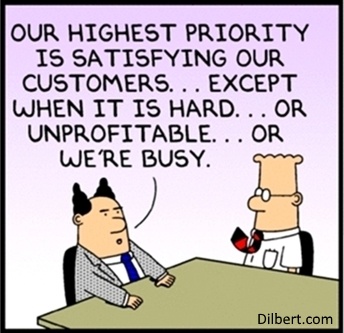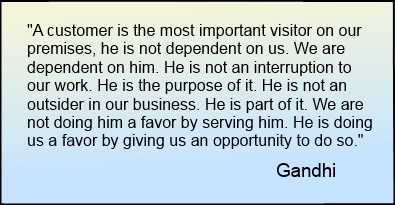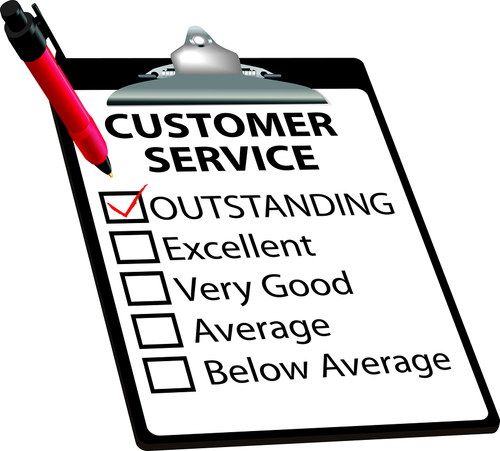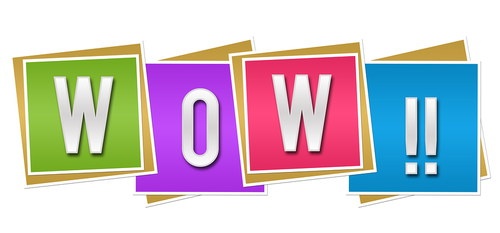As most of you know, I once had an accounting practice that also specialized in business coaching. As my interest grew in business systems and processes, I began to apply the principles to my own organization—Carroll and Company. Even I, your humble Systems Thinker, was impressed as I recently read some of the things we did back then to deliver first-rate customer service.
Below is an overview document written in 2004 describing our business system for providing “killer-customer-care.” It may be a little outdated, but good customer service is based upon true and enduring principles, so adapt it to your modern-day methods and technologies. (Also, please forgive my frequent use of the term “she.” Our receptionist and customer-care person was female, so I wasn’t as gender-neutral as I would be if writing today.)
Keep in mind, this system overview refers to a number of other component documents that were an important part of our customer-care system. (Component documents, like those italicized below, are now an integral part of creating systems and processes using Box Theory™ Software.
This article is a little longer than usual, and probably more information than you need. However, it contains many useful ideas; even one could lead to an important improvement for your business. More than anything, I hope it gives you a vision of what goes into creating a high-performance business system. If you give your customer-service system the attention it deserves, (not like the cartoon below), your company can become remarkable. Enjoy!

Photo credit: WordPress.com
Carroll and Company Customer-Care System Overview
The Customer Advocate
The Customer Advocate is a Carroll and Company employee assigned to view all customer contacts and customer-care activities from the customer’s point of view. This person continually assists customers, monitors the customer experience, reports problems to management, and recommends ways of improving customer care.
The Customer Advocate performs the duties defined in the document Customer Advocate Responsibilities. These duties include new client intake and orientation, the customer relationship management (CRM) database, customer surveys, monthly customer email contacts, the customer-care calendar and budget, and special customer events or activities.
Customer-care Contacts
A customer-care contact takes place any time a client or one of their employees enters the physical space of Carroll and Company. A customer enters the space by walking in the front door or by calling over the telephone. Whenever a customer enters this space and interacts with Carroll and Company employees, they are given utmost courtesy and prompt attention to their needs. The employee “puts on their best face” as described in the killer-customer-care philosophy.
While on duty, the Customer Advocate/receptionist for Carroll and Company has stewardship for all customer contacts that take place. The person is sensitive to customer comfort, waiting times, the fulfillment of commitments, and meeting or exceeding customer expectations.
All management and staff employees practice the killer-customer-care philosophy during any engagement with clients, including those at the client’s workplace. All outgoing email communications from Carroll and Company use the prescribed logo and signature. Email communications are always courteous and professional (see document Email Etiquette).
The Carroll and Company Customer-Care System includes the following guidelines.
Carroll And Company “Sensation”
When clients visit Carroll and Company, they will have an overall feeling or “sensation” about the experience. Our goal is to make the experience as pleasant as possible. This begins with a clean and organized office. The temperature is set at a comfortable level (70-74 degrees). The person is greeted with a smile, addressed by their first name, and quickly served in a polite and professional manner. The client leaves Carroll and Company feeling that they accomplished their purpose. Sometimes they leave thinking, “WOW!”
Client Visits
When a client or their employee enters the reception area of Carroll and Company, they get immediate attention. If the receptionist is on the phone, she motions the person to have a seat. Addressing the client by name—when possible—she seeks to know who they have an appointment with, or what they have come to drop off or pick up. (By asking, “Do you have an appointment?” customers are trained to prearrange their visits to the office.) The receptionist immediately notifies the appropriate manager or staff that the client has arrived. If not already sitting, she invites the guest to take a seat and offers them a bottle of water. Wrapped candies also fill a bowl on the waiting-room table.
The receptionist continues to monitor people in the waiting area and strives to be interested and helpful, chatting with them if they would like to talk. The receptionist may also conduct a brief Client Survey (see below) while the customer is waiting.
The receptionist is sensitive to the length of time the client has been waiting. Response from Carroll managers or staff should be prompt, no more than three to five minutes. The receptionist contacts the Carroll employee if their response time is longer and informs the waiting person what they can expect. Most meetings with clients should take place in the conference rooms. Clients are discouraged from going into other parts of the building. Conference rooms are scheduled when possible.
Client Inbound Calls
When customers call the office, they are greeted by a smile (even though they can’t see it) and the statement “Good Morning, Carroll and Company, this is [Mary].” During the conversation, the greeter finds out the first name of the caller and the company they represent. The greeter also gets the phone number if the person wishes to be called back.
The receptionist/greeter works for the caller until his or her needs are met. She listens, takes action, and follows up as necessary to ensure the caller has a positive experience. The receptionist’s duty ends only when a call is successfully transferred, the customer leaves a voice mail, or the customer chooses to call back later.
If the client wants to be called later by a manager or staff, or if the call is urgent, the receptionist gives a detailed post-it to the manager or staff upon their return. If the client needs to be reached immediately, the receptionist should facilitate a mobile-phone contact.
The receptionist monitors a caller who is on hold and speaks with them every thirty seconds until the call is taken by the staff. If the customer is anxious or frustrated, they are assisted in every way to resolve their problem. The Carroll and Company on-hold music/information/light advertising CD should be checked daily to make sure it is working properly. The receptionist also monitors and updates the after-hours voice message.

View 50 more enlightening customer-service quotes
Remember: exceptional customer service is everyone’s job. Make a good impression. You may be the first and only contact a caller has with our company. Their feelings about the experience will stay with them long after the call is completed. Use phrases such as “please” and “thank you.” Apply the Golden Rule to treat them the way you would like to be treated. Keep your promises. If you say you are going to call them back within a certain time, do it! Every contact strengthens or weakens the customer relationship.
All telephone activities should follow the guidelines contained in the document Telephone Etiquette, and in the section “Put on Your Best Face” in the killer-customer-care philosophy.
Finally, receptionists/greeters are trained to excel at telephone etiquette. They should take phone calls most of the time. However, all employees should have basic customer-service and telephone-etiquette skills. Every person who has contact with clients represents Carroll and Company, their team, and themselves. Let’s be at our very best!
Internal Communication and Commitments
Clients must receive excellent customer care at all times during the day. Because some part-time employees come and go from Carroll and Company, it is extremely important that there is good communication at every level. This is particularly consequential when commitments made to the client must be filled by another employee.
Employees check-in with the receptionist when they arrive for work. They check-out when they depart the building. This lets the receptionist know who is available to work with customers. When employees leave, they also indicate the next time they will be back in the office. If it is anticipated that the client will have any needs while the employee is away from the office, a co-worker or the receptionist is informed so that the client can continue to receive service. The coming and going of staff should not adversely affect clients, causing them to feel frustrated with their outsourced accounting solution.
New Client Intake
When a new client hires Carroll and Company, a variety of internal tasks are performed to get the client set up and ready for service. As soon as possible, the Customer Advocate completes all tasks detailed in the New Client Intake Checklist.
New Client Orientation
The Customer Advocate holds a brief 20-30-minute orientation meeting with all new clients (except payroll only clients). This is usually held in a Carroll and Company conference room at a time convenient to the client and within a week of signing the Client Agreement. The Customer Advocate follows the New Client Orientation Checklist.
Client Database and Pictures
Customer Relations Management (CRM) software contains the records of all sales prospects and customers. Current clients should be flagged in the software in order to exclude or include them in advertising pieces. At the new client orientation meeting, relevant company and contact information is obtained using the New Client Information form. This is later entered on the CRM database along with pictures taken of managers or key employees. A primary purpose of pictures is to allow Carroll staff to become familiar with clients, and so they can address them by their first name.
Client Feedback and Surveys
It is very important for Carroll and Company employees to understand the feelings and expectations of valued clients. This is done by listening to their spontaneous remarks, complaints, or suggestions during contact or at a monthly client meeting. It is also accomplished by asking the client through a formal feedback system such as a customer survey. Client feedback must be routinely captured, forwarded to management, analyzed, and acted upon.
The Carroll and Company Client Survey is conducted on a continuous basis—twice a year with each client. It is administered to 5% of clients per week over a twenty-week period. It can be conducted by phone, during client visits, or at monthly client meetings. Survey results, along with customer suggestions and complaints, are analyzed and discussed during weekly management meetings or at a business improvement workshop. They are also compiled in a final report at the end of the six-month survey period.

Client Comments Request Form
It is important for Carroll and Company and our accounting teams to recognize all significant accomplishments in working with clients. This increases motivation, strengthens relationships, and creates valuable goodwill. Many clients have become more profitable and successful using the Carroll and Company outsourcing model. We would like to capture some of those feelings as written testimonials.
To make this a simple task, we have created the Client Comments Request Form that lists common phrases used by our clients in the past. Clients can check any that represent their feelings and add comments if they desire. We will write a brief statement that reflects their thoughts and seek permission to use the statement in our sales process.
The best time to get a testimonial is:
- After a successful business evaluation
- After early success in getting the company financially on track
- After a major financial turn-around
- After a significant year of profitability
- After a single important financial accomplishment
- Anytime an owner speaks verbal praises of the company, accounting team, or service
As a “Thank You,” Carroll and Company provides the client two $20 gift certificates for dinner at the Outback Steakhouse.
Website and Newsletter
Carroll and Company provides valuable information to customers through a monthly newsletter called Profitable Times. This newsletter is designed for busy entrepreneurs who need timely and specific information to manage their company more effectively and profitably. The newsletter offers advice from industry experts in accounting, tax, personal financial planning, sales and marketing, customer service, and human resource. The Profitable Times Newsletter is distributed the middle Tuesday of each month to clients and prospects of Carroll and Company. All articles are archived for future reference in the website Library. The Customer Advocate manages the subscription list.
Client Email Contacts
Carroll and Company maintains a Customer Email Distribution List in Microsoft Outlook and sends a general email to all clients and their key employees once or twice a month. This email may include a thought-of-the-day, tax deposit dates, office close dates, client promotions, or other useful information. The email uses Carroll and Company authorized logos and artwork and is approved by Ron prior to sending.
Client “WOW” Activities
Carroll and Company has a limited budget for doing special activities to “surprise and delight” clients. These activities may recognize an important accomplishment of the client, or they may be general activities targeted to all clients. Events or activities could include sponsoring a client’s office pizza party, giving away a free business book, having a summer picnic, or taking clients to a seminar. These “WOW” activities are targeted to an approved list of clients. Creative ideas are welcomed.

Customer-care Calendar and Budget
Carroll and Company produces a Three-Month Calendar of employee events, customer care, and marketing activities. The Customer Advocate is responsible for updating the company calendar with all scheduled customer-care activities. They include client surveys, WOW activities, new client orientations, monthly customer emails, birthday wishes, and so forth. Calendar activities for each quarter are completed two weeks prior to the end of the current quarter. A budget is also submitted to fund the proposed activities.
Client Nurturing Activities
CFOs and controllers are encouraged to develop friendships with their clients by taking them to lunch, playing golf, or other relationship-building activities. Because of the cost and time involved, nurturing activities should be occasional and serve a specific purpose. These activities are at the discretion of the manager and require a personal, out-of-pocket expense.
Customer-care Training and System Improvement
At Carroll and Company, customer care is everyone’s job, regardless of other responsibilities. All employees should seek to create a company culture committed to the sincere caring, guidance, and protection of our clients. To achieve end-to-end killer-customer-care requires teamwork and shared goals, which means all business systems and incentives must reward customer care and never conflict with it.
The principles of remarkable customer service are taught at new employee orientations, weekly management meetings, team meetings, business improvement workshops, and by customer-care stories (see below). Killer-customer-care must be talked about often. Client Survey results are shared. Success and horror stories are told. Information is analyzed, and improvements are made to the customer-care system.
Email Stories to Staff
The Customer Advocate and receptionist monitor customer experiences at all times. Once a week, the Customer Advocate emails to all employees of Carroll and Company a customer experience story. The story can be a success story, or it can be an experience to learn from. The purpose of these stories is to teach the principles of killer-customer-care and to remind employees that customer care is everyone’s job.
Monthly Client Meetings
The monthly client meeting and delivery of the Profit Acceleration System™ is the most important face-to-face contact with the client. An outstanding and productive meeting is killer-customer-care at its best. The customer binder, with a vision statement, business blueprint, monthly agendas, financial summaries, analysis and forecasting, and goal sheet, should WOW the customer every time. This is what separates us from the competition and is at the heart of the Carroll and Company Customer-Care System.
Well, That’s It
I’m exhausted just thinking about this business system, and the work it took to get it going. Retirement feels pretty good right about now.
However, you should know this: it took me several weeks of full-time work—free from distraction—to develop this system and all the component documents that were mentioned in italics. Once going—and a few kinks worked out—the system ran on auto-pilot, and a lot of great things happened with our clients and our employees. (Completing this system also moved me one more step toward retirement.)
You may have a different type of business, or this may be more than you want to tackle right now. But, remember this: 1) customer care is everyone’s job and essential to having a culture of excellence, 2) customer service must be systemized to consistently meet and exceed customer expectations, and 3) customer feedback is the key to achieving continuous improvement.
Your answer to three questions will determine if you are on track. Are your customers loyal? Do they refer others? Would you be a satisfied customer of your own company?
And one last thing, I didn’t have Box Theory™ Software back then. Now, I could create this business system in half the time. Your cost savings with this tool will be more than good. However, the amazing skill you learn will be even better, and the remarkable business you become will make you the best in your target market! So, don’t wait any longer. Get going today.
Footnote:
Consider the following terms (italicized above) as you contemplate your new and improved customer-care system:
Killer-customer-care philosophy and business system
Customer advocate
The customer contact
The customer sensation
New customer orientation
Customer intake
WOW Activities
Customer-care calendar and budget
Customer feedback/survey
Customer testimonials
Monthly newsletter or email communications
Business Improvement workshop for customer care
Related Articles:
Create a Symphony of Business Systems to Delight Customers!
The Business System that can Make or Break a Company!
Voice of the Customer: Four Things That Will Earn You an “A”!
How To Become the “Best Deal” for Your Target Customer!
Customer Service: Best Practices for an Awesome Customer Care System (slideshow)!







